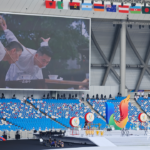Three Chinese ministries on Friday issued a two-year action plan to stabilize growth of the light industry, which is less capital-intensive and more consumer-oriented manufacturing of smaller consumer goods and the backbone of the Chinese economy, vowing a range of measures to keep an average growth rate of 4 percent in 2023 and 2024.
The action plan, released by the Ministry of Industry and Information Technology, the National Development and Reform Commission and the Ministry of Commerce, comes just days after a top meeting of the Political Bureau of the Communist Party of China Central Committee on Monday called for greater efforts to ensure “reasonable growth” amid “new challenges.”
The plan aims to expand consumption demand and promote steady growth in the light industry, so as to offer support for the improvement of the country’s overall economic operation. It sets a growth target of 4 percent on average in 2023 and 2024 for the sector’s industrial added value, while revenue of major light industry companies is set to exceed 25 trillion yuan.
That represents a significant improvement from 2022. Last year, China’s light industry saw a 2.4 percent growth year-on-year in industrial added value, while the combined revenue of major enterprises in the sector stood at 24 trillion yuan, up 5.4 percent year-on-year, according to data from the NDRC.
The light industry, mainly referring to manufacturing of smaller consumer goods such as clothes, food, toys, plastic products, and home appliances, is crucial for boosting consumption. And consumption is paramount for China’s economic growth, which leads officials to focus on boosting consumption in effort to stabilize growth amid domestic and external downward pressure.
To stabilize growth in the light industry, the action plan on Friday vowed various measures to support major areas, including home appliances, plastic products, paper manufacturing, leather and food.
Notably, the action plan vowed to accelerate the research and application of key technologies and materials in the fields of lead-acid batteries, lithium-ion batteries, and primary batteries. It pledged to vigorously develop high-safety lithium-ion batteries, lead-carbon batteries, sodium-ion batteries and other products, and expand their applications in new-energy vehicles (NEVs), energy storage, telecommunications and other fields.
Manufacturing of batteries and NEVs has become a highlight of China’s economic development. In 2022, industrial added value for the subsector of battery grew more than 10 percent year-on-year, compared to the 2.4 percent growth of the light industry. In the first quarter of 2023, China overtook Japan to become the world’s biggest exporter of cars, with total exports reaching 1.07 million units, up 58 percent year-on-year, according to official data.
The action plan also includes measures to stabilize exports of the light industry, including exploring new emerging markets such as those along the Belt and Road Initiative route and those under the Regional Comprehensive Economic Partnership. Efforts will be taken to establish border trade markets on borders with Southeast Asia, Central Asia and Northeast Asia. The plan also supports small and-medium enterprises to take advantage of existing capital sources to attend overseas trade fairs and increase orders.
(Global Times)




